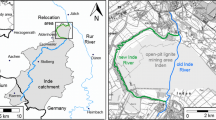Abstract
The Digital Elevation Model (DEM) based on the historical sea-charts and on-site hydrological records were used to examine the morphological change of the Elbe River estuary. The results show that siltation predominated in the tidal flat in the northern estuary, with a net siltation rate of 1.8 cm·a−1 during 1927–2006. In contrast, a continuous erosion prevailed in the main river channel, south of the estuary, with a net erosion rate of 2.5 cm·a−1 in the same time. In addition, a seaward shift of the estuarine island has happened with the old island coalescing to the northern tidal flat and new one emerging through siltation process. The tidal asymmetry via ebbing flow (maximum at 140 cm·s−1, and average at 76 cm·s−1) prevailed in the tidal flat, meaning continuous aggradation northwestward, while flooding flow (maximum at 100 cm ·s−1, and average at 67 cm·s−1) dominated in the main river channel with deepening thaweg at south, showing a landward sedimentation via the tidal pumping processes. This dextral extension of the estuarine morphology is due to the Coriolis force, leading to the inconsistent directions of in-out flows, which enables to facilitate the estuarine siltation. Human dredging prevailing in the estuary has dramatically altered the nature of the silted river channel to erosional since the last century. This is characterized by a net erosion rate of 3.2 cm·a−1 derived from the DEMs mapping, but only partially accounting for the dredging amount of 1994–2006, when the total dredging volume was 67 × 106 m3, equal to 5.9 cm·a−1.
Similar content being viewed by others
References
Adams M S, Kausch H, Gaertner K (2000). Historical changes and a modern program to improve the ecology of the Alster River of Germany. Urban Ecosyst, 4(3): 171–192
Baborowski M, Büttner O, Morgenstern P, Krüger F, Lobe I, Rupp H, Tümpling W V (2007). Spatial and temporal variability of sediment deposition on artificial-lawn traps in a floodplain of the River Elbe. Environ Pollut, 148(3): 770–778
Beets D J, Spek A J F (2000). The Holocene evolution of the barrier and the back-barrier basins of Belgium and the Netherlands as a function of late Weichselian morphology, relative sea-level rise and sediment supply. Geol Mijnb, 79(1): 3–16
Bergemann M (2006). The Elbe River estuary. In: Dauvin J C ed. North-Atlantic Estuaries: Problems and Perspectives. Seine-Aval Special Issue, 20–85
Brönnimann S, Luterbacher J, Staehelin J, Svendby T M, Hansen G, Svenøe T (2004). Extreme climate of the global troposphere and stratosphere in 1940–42 related to El Niño. Nature, 431(7011): 971–974
Carstens M, Claussen U, Bergemann M, Gaumert T (2004). Transitional waters in Germany: the Elbe estuary as an example. Aquat Conserv, 14(S1): 81–92
Chen Z, Saito Y, Goodbred S L eds (2005). Mega-deltas of Asia-Geological Evolution and Human Impact. Beijing: Ocean Press, 1–268
Chen Z, Watanabe M, Wolanski E (2007). Sedimentological and ecohydrological processes of Asian deltas: the Yangtze and the Mekong. Estuar Coast Shelf Sci, 71(1–2): 1–2
Coleman N (1986). Effects of suspended sediment on the open-channel velocity distribution. Water Resour Res, 22(10): 1377–1384
Gerritsen H, Vos R J, van der Kaaij T, Lane A, Boon J G (2000). Suspended sediment modelling in a shelf sea (North Sea). Coast Eng, 41(1–3): 317–352
Goodbred S L, Kuehl S A (2000). Enormous Ganges-Brahmaputra sediment discharge during strengthened early Holocene monsoon. Geology, 28(12): 1083–1086
Ionita M, Lohmann G, Rimbu N (2008). Prediction of spring Elbe discharge based on stable teleconnections with winter global temperature and precipitation. J Clim, 21(23): 6215–6226
Jones J E, Howarth M J (1995). Salinity models of the southern North Sea. Cont Shelf Res, 15(6): 705–727
Knudsen K L (1992). Late Elsterian-Holsteinian foraminiferal stratigraphy in boreholes of the Lower Elbe area, NW Germany. Geol Jahrb, 138: 97–119
Li M T, Chen Z Y, Yin D W, Chen J, Wang Z H, Sun Q L (2011). Morphodynamic characteristics of the dextral diversion of the Yangtze River mouth, China: tidal and the Coriolis Force controls. Earth Surf Process Landf, 36(5): 641–650
Merkt J (1984). Shoreline displacement and lake development in the Bederkesa area. Subcommission on Shorelines of Northwestern Europe. In: Field Conference 1984—North Sea Coastal Zone between Jade Bay and Jammer Bight, Niedersachsisches Landesamt fur Bodenforschung, Germany: Hannover, 32–41
Nittrouer C A, Kuehl S A (1995). Geological significance of sediment transport and accumulation on the Amazon Continental Shelf. Mar Geol, 125(3–4): 175–176
Roe H M (1999). Late Middle Pleistocene sea-level change in the southern North Sea: the record from Eastern Essex, UK. Quat Int, 55(1): 115–128
Sohrmann A, Weilbeer H (2006). Influence of anthropogenic measure on sediment transport characteristics the Elbe River estuary—hindcast studies on different historical states with a three-dimensional model. In: The 7th International Conference on Hydroscience and Engineering (ICHE-2006), USA: Philadelphia, 1–22
Streif H (2004). Sedimentary record of Pleistocene and Holocene marine inundations along the North Sea coast of Lower Saxony, Germany. Quat Int, 112(1): 3–28
Vanmaercke M, Poesen J, Verstraeten G, Vente J D, Ocakoglu F (2011). Sediment yield in Europe: spatial patterns and scale dependency. Geomorphology, 130(3–4): 142–161
Veenstra H J (1982). Size, shape and origin of the sands of the East Frisian Islands (North Sea, Germany). Geol Mijnb, 61(2): 141–146
Winterwerp J C (2001). Stratification effects by cohesive and non-cohesive sediment. J Geophys Res, 106(C10): 22559–22574
Woodroffe C D, Nicholls R J, Saito Y, Chen Z, Goodbred S L (2006). Landscape variability and the response of Asian Megadeltas to environmental change. In: Harvey N ed. Global Change and Integrated Coastal Management. New York: Springer, 277–314
Author information
Authors and Affiliations
Corresponding author
Rights and permissions
About this article
Cite this article
Li, M., Ge, J., Kappenberg, J. et al. Morphodynamic processes of the Elbe River estuary, Germany: the Coriolis effect, tidal asymmetry and human dredging. Front. Earth Sci. 8, 181–189 (2014). https://doi.org/10.1007/s11707-013-0418-3
Received:
Accepted:
Published:
Issue Date:
DOI: https://doi.org/10.1007/s11707-013-0418-3




